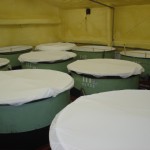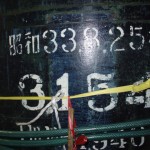Sake is no longer brewed in wooden tanks. In fact, they began to be phased out about 70 years ago and have pretty much been non-existent since just after the war. They were replaced by what is almost exclusively used today, ceramic-lined stainless steel, or sometimes, bare stainless steel.
Why were they phased out? A number of reasons. One, for the most part, brewers do not want to impart the woodiness into their sake (taru-zake is one exception). The line between character and idiosyncrasy is not just crossed, it is shattered with woody sake.
Next, the wood absorbs some of the sake during fermentation, so yields are a bit reduced – so much so that in days of olde brewers were given a break on taxes for sake absorbed by the wood. And the grain of the wood is very hard to clean thoroughly, and provides a hotbed for bacteria. With the ceramic lined tanks, brewers can just hose’em off when done.
Interestingly, long ago, when wood was used, they did not at that time either want to make their sake overly woody. So when a tank was made by the coopers that were such an indispensible part of the brewing team, it was not used to make sake right away. Rather, it sat around for a few years to air out, and/or was used to store water or rice. It did not earn the right to have anything ferment in it until the woody essences had slowly evaporated.
As always in the sake world, there are exceptions. There are a handful of brewers that do make sake in wooden tanks. But really, it is maybe 30 out of 1300, and they make perhaps one to three batches a year in wood. It is by no means a trend or movement, just an anomaly.
 Which is not to diss the sake that comes from those tanks! It can be quite interesting, and perceptibly different. Surely just a bit of wood gets imparted, but often the flavors end up quite integrated and fine-grained.
Which is not to diss the sake that comes from those tanks! It can be quite interesting, and perceptibly different. Surely just a bit of wood gets imparted, but often the flavors end up quite integrated and fine-grained.
Sake brewed in wooden tanks, what little of it there exists, is called ki-oke jikomi. While not very common, if you come across the term, now you know.





